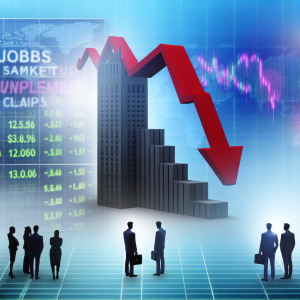Insured Unemployment Hits Highest Point Since 2021: What Investors Need to Know Now
The latest labor market data reveals a subtle but significant shift that savvy investors and advisors can’t afford to ignore. Insured unemployment—the number of workers actively claiming unemployment benefits—climbed by 10,000 to 1,965,000 in the week ending June 28, marking the highest level since November 2021. While the insured unemployment rate held steady at 1.3%, the upward trend in claims signals a labor market that’s showing signs of softening beneath the surface.
Why This Matters: A Signal of Labor Market Slack
This rise in insured unemployment, alongside a four-week average increase to nearly 1.96 million claims, suggests a slower pace of rehiring for laid-off workers. For investors, this is a critical barometer of economic resilience. The Federal Reserve closely watches these labor market dynamics as it calibrates its inflation-fighting strategies and interest rate policies. A persistent elevation in unemployment claims could temper the Fed’s enthusiasm for aggressive rate hikes, potentially reshaping the trajectory of markets sensitive to borrowing costs.
Regional and Sectoral Nuances: Reading Between the Lines
Digging deeper into state-level data uncovers a patchwork of labor market pressures. States like New Jersey (+4,684 claims), New York (+3,323), and Illinois (+1,840) are experiencing upticks in layoffs, particularly in education, healthcare, manufacturing, and transportation sectors. These sectors are often bellwethers for broader economic health, as they impact everything from consumer spending to supply chain stability.
Conversely, states such as Pennsylvania (-2,910) and California (-2,822) saw declines in claims, driven by improvements in transportation and hospitality layoffs. This divergence underscores the importance of a localized approach to investment decisions. For example, an investor eyeing retail or hospitality stocks might favor companies with a strong presence in states showing labor market resilience, while adopting caution in regions facing sectoral downturns.
Broader Implications: Consumer Confidence and Spending
Total continued claims across all unemployment programs rose by nearly 38,000 to 1.93 million for the week ending June 21. While some seasonal variation is expected, the sustained higher baseline of claims points to potential headwinds for consumer confidence and discretionary spending. Consumer spending accounts for roughly 70% of U.S. GDP, so any softness here can ripple through the economy, affecting sectors from retail to travel.
Market Outlook: A Cautiously Bearish Stance on Labor-Linked Sectors
The mixed signals—easing initial claims but rising insured unemployment—suggest a cautiously bearish near-term outlook for labor-sensitive sectors. Discretionary retail, travel, and leisure industries, which rely heavily on consumer confidence and robust employment, may face continued volatility.
Investors should keep a close eye on upcoming payroll reports and inflation data. Persistent elevated claims may push the Fed toward a more dovish stance, potentially slowing the pace of rate hikes. This scenario could create short-term relief for interest rate-sensitive assets but also signals a softening labor market that could weigh on corporate earnings.
What Should Investors and Advisors Do Differently Now?
-
Adopt a Sector-Specific Lens: Avoid broad-brush investment strategies. Focus on sectors and regions showing resilience in labor markets. For example, tech and healthcare companies with strong hiring trends in states with lower unemployment claims may outperform.
-
Monitor Consumer Sentiment Metrics: With a higher baseline of unemployment claims, consumer spending could become more cautious. Track real-time data on retail sales, credit card spending, and consumer confidence indices to anticipate shifts.
-
Prepare for Fed Policy Nuance: The Fed’s next moves may be less aggressive if labor market slack persists. Fixed income investors should consider positioning for a potential pause or slowdown in rate hikes, while equity investors might look for opportunities in sectors that benefit from lower borrowing costs.
-
Watch for Earnings Warnings: Companies in labor-intensive sectors might start issuing cautious earnings guidance. Stay nimble and ready to adjust portfolios in response to these signals.
Looking Ahead: What’s Next?
As we move deeper into the second half of 2024, the labor market will remain a pivotal factor shaping investment landscapes. According to the latest data from the U.S. Bureau of Labor Statistics and corroborated by insights from the Federal Reserve Bank of Atlanta, the labor market is transitioning from tight to more balanced conditions. This recalibration offers both risks and opportunities.
A unique insight for Extreme Investor Network readers: consider exploring mid-cap companies in the logistics and healthcare sectors, which have shown resilience in recent quarters despite sectoral layoffs elsewhere. These firms often have more agility to navigate labor market fluctuations and can offer attractive growth potential as the economy adjusts.
In summary, the rise in insured unemployment is not just a number—it’s a signal that the labor market is evolving. Investors who integrate this nuanced understanding into their strategies will be better positioned to navigate the complexities ahead and capitalize on emerging opportunities.
Sources:
- U.S. Department of Labor, Unemployment Insurance Weekly Claims Report
- Federal Reserve Bank of Atlanta, Labor Market Analysis
- U.S. Bureau of Labor Statistics, Employment Situation Summary
Stay tuned to Extreme Investor Network for ongoing, expert analysis that keeps you ahead of the curve in today’s dynamic market environment.
Source: US Jobless Claims Drop, But Rising Unemployment Signals Trouble Ahead

